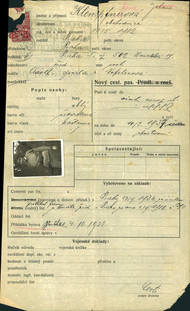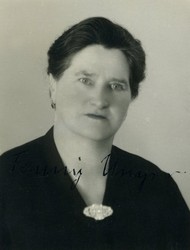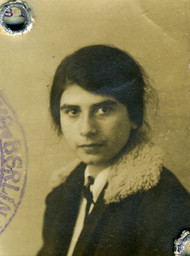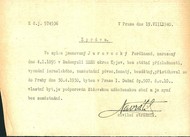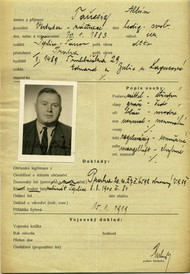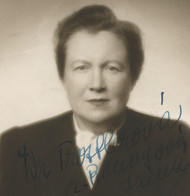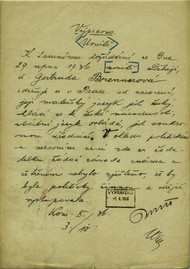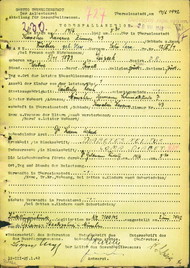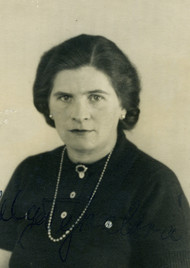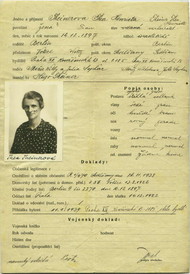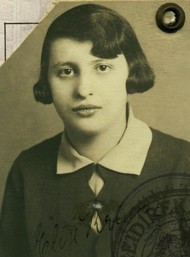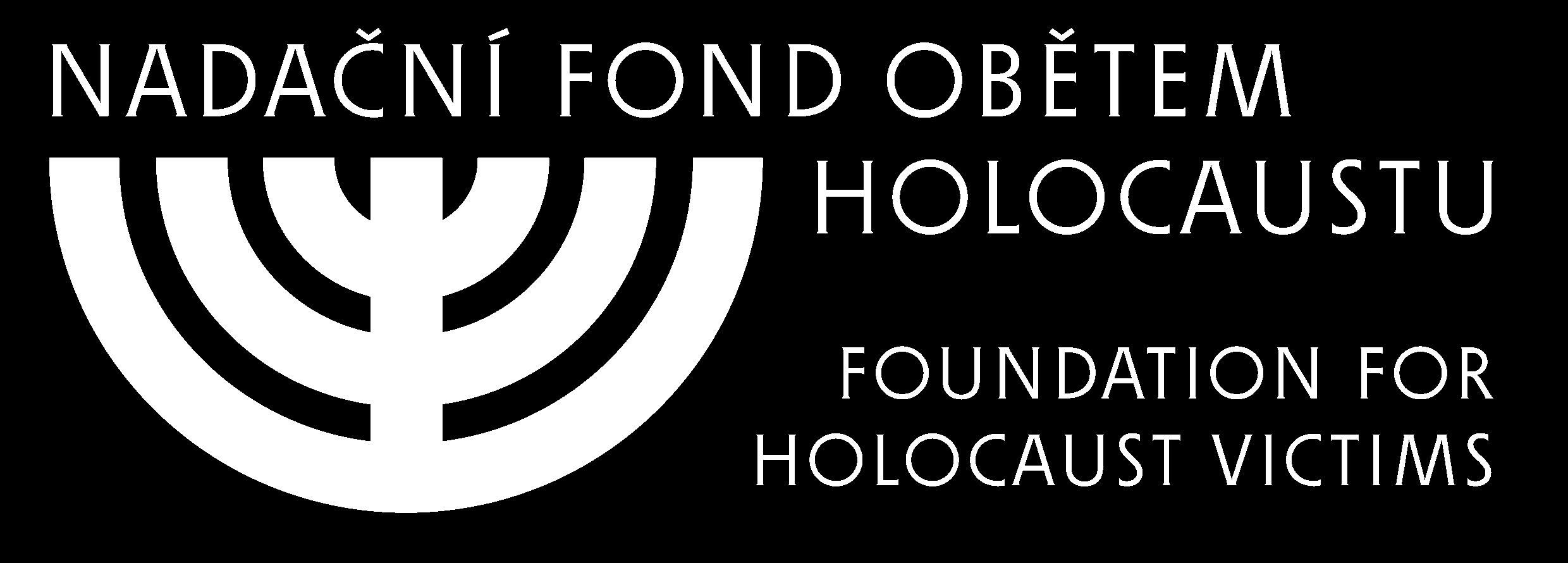Key and copyright. (In Czech)
Treblinka, together with the camps at Bełżec and Sobibor, was one of the Operation Reinhard
extermination camps, so called in memory of Reinhard Heydrich. It was located in the sparsely-populated north east of the Generalgouvernement area, on the Warsaw-Białystock line, close to an existing penal camp founded in 1941. Work on the camp's construction started in the end of May 1942, and by the 22nd of July of the same year the camp was completed.
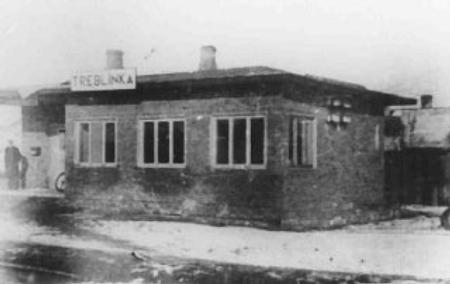
The station at Treblinka. The photo comes from the archive of camp commander Kurt Franz, 1942 - 1943. (Photo: Bildarchiv Preussischer Kulturbesitz, courtesy of USHMM Photo Archives.)
The camp was divided into three parts. The first was for the use of the staff, who consisted of Germans and Ukrainians, as well as Jewish prisoners who worked there in carpentry, cobblers' and metal-working workshops. The second consisted of space for the reception and assembly of prisoners. The third part was the extermination area, in which the gas chambers, mass graves and woodpiles for the cremation of prisoners were situated. This part was connected with the reception part by a narrow broken alley known as the pipe
- Schlauch
- along which the Jews were driven into the gas chambers.
Treblinka was a true death factory. Immediately after getting off the train, people went to the gas chambers. There was no tattooing, no huts with wooden bunks, no louses, not even any harsh labour. From the start, three gas chambers were in operation, with dimensions of 4 by 4 metres and a capacity of 300 to 500 people an hour. In September 1942, a further ten gas chambers were added, with a much greater capacity. They allowed between 1 000 and 2 000 people to be put to death in an hour.
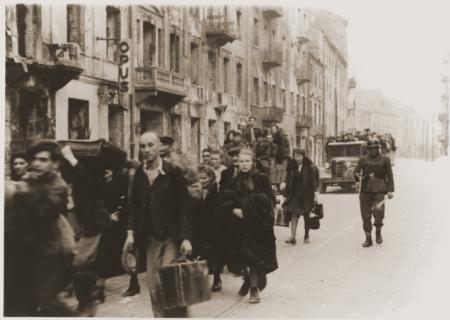
Jews arrested after the suppressed uprising in the Warsaw ghetto leave for a transport to Treblinka, 19. April - 16. April 1943. (Photo: National Archive, courtesy of USHMM Photo Archives.)
The transport trains, each with forty to fifty trucks and carrying 6 000 to 7 000 prisoners, ended their journey at the station in the village of Treblinka, 4 km from the camp. From there, they were sent to the camp 20 trucks at a time. The deportees were driven out of the trucks, the men were separated from the women and children and all were forced to strip naked. Then they were driven down the Schlauch into the bath house
, where they died of gas poisoning within about 15 minutes. After the procedure was finished, Jewish prisoners dragged the corpses out through the back doors. Initially the bodies were buried in mass graves, but later they were burned, on the orders of Heinrich Himmler, who visited the camp in late February and early March 1943. This was also required of the victims that had already been buried, and so the mass graves had to be opened and the bodies burned. The remains and the ash were thrown back into the graves.
In the reception part was a building above which there was a flag with a red cross, the Lazarett
. This is where people unable to walk to the bath house
by themselves were taken. Instead of receiving medical care, however, they were immediately killed.
The abandoned trucks were cleared out, another twenty trucks arrived in their place and the whole process was repeated. The clothes and items left by the victims in the deportation barracks before the shower
were sorted. Gradually, bankers and goldsmiths were selected from the transports and formed into a commando called the Goldjuden - Gold Jews. Their job was to collect and classify any valuables, which were then vigorously traded by Germans, Ukrainians and the local population.
The first transports to Treblinka came from the Warsaw ghetto. Between the 23rd of July and the 21st of August 1942, a total of 254 000 Jews from Warsaw and 112 000 from other parts of the Warsaw region were murdered here. 337 000 Jews were killed from the Radom area, and 35 000 from Lublin and its surroundings. In total 738 000 Jews from the Generalgouvernement area were killed in Treblinka.
More than 107 000 people were deported here from the Białystok area, the majority between November 1942 and January 1943. 7 000 Jews came from Slovakia, who were first imprisoned in the Polish ghettos, dying in Treblinka in summer and autumn 1942. There were ten transports from Terezín with 18 000 people, in September and October 1942. In March and April 1943, approximately 11 000 Jews from Macedonia and Thrace, areas newly attached to Bulgaria, were deported to Treblinka, while at the end of March 2nd,800 Jews also came from Thessaloniki. Over 2 000 Roma also died here.
The total number of people murdered in Treblinka is estimated at 870 000.
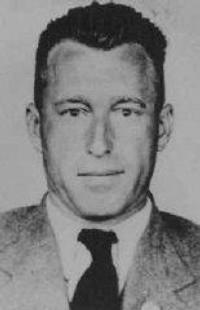
Franz Stangl, commander of the Treblinka extermination camp from 1942 - 1943. (Photo: The Jacob Rader Marcus Center of the American Jewish Archives, courtesy of USHMM Photo Archives.)
The first commander of the camp was SS-Obersturmführer Imfried Eberl. In August 1942, he was replaced by SS-Obersturmführer Franz Stangl, previously the commander of Sobibor. From April 1942 on, the camp's commander was Kurt Franz, Stangl's erstwhile deputy. The staff consisted of 20 to 30 Germans, who held leading functions, and approximately 120 Ukrainians, who served as guards. Most of them were Soviet prisoners of war, trained in Trawniki. In addition, over 700 Jewish prisoners were used for slave labour, which included keeping the gas chambers working and burying the bodies of the victims.
In 1943, a resistance group emerged among the prisoners used for slave labour, joined by many of the kapos and leaders of working groups. Its attempt to create a rebellion failed, however. The leadership of the resistance movement was taken over in the end by a former officer in the Czechoslovak army, Zelo Bloch. The uprising, planned from April 1943, began on the 2nd of August 1943. The prisoners took weapons and grenades out of a storeroom for which they had made a key. They managed to set fire to the building in which the Germans and Ukrainians lived, and gradually all the buildings in the camp caught fire. The prisoners tried to climb over the barbed fortifications, but many of them were shot from the watch towers. Others managed to flee into the marshy woods, but of the seven hundred prisoners, only around 70 escaped.
The rest of the prisoners, who did not manage to escape, were forced to destroy and obliterate all evidence of the activities that had gone on in the camp. Afterwards they too were shot, and a farm was built on the site of the extermination camp.
Between 1959 and 1969 a memorial was constructed on the site of the camp, in the form of a cemetery. Hundreds of stone tombs bear the names of the countries and districts from which the victims came.

The symbolic cemetery on the site of the former extermination camp, 2001. (Photo: M. Stránský)
After the war, Franz Stangl fled to Brazil, from whence he was extradited back to Germany. He stood on trial between the 13th of March and the 22nd of December 1970, and received a life sentence. Asked How many people could be killed in Treblinka in a day?
he replied: According to my estimation, a transport of thirty freight cars or with 3 000 people was liquidated in three hours. When the work lasted for about fourteen hours, 12 000 to 15 000 people were annihilated. There were many days that the work lasted from the early morning until the evening... I have done nothing to anybody that was not my duty . My conscience is clear.
-
See also:
-
Treblinka: On the history of the most efficient of the
Operation Reinhard
extermination camps.. (In Czech).
-
Literature:
-
Glazar, Richard. Treblinka, slovo jak z dětské říkanky (Treblinka, wie ein Wort aus einem Kinderreim). Praha: Sefer, 1994. 420 s.
-
Arad, Yitzhak. Belzec, Sobibor, Treblinka. Bloomington: Indiana University Press, 1987. 437 s.
-
Kárný, Miroslav. Osud terezínských východních transportů v létě a na podzim 1942 (Das Schicksal der Theresienstädter Transporte nach Osten im Sommer und Herbst 1942). In: Litoměřicko. 1988, sv. XXIV, s. 160-165.
-
Glazar, Richard. Autentická historie vyhlazovacího tábora Treblinka - líčení očitého svědka. In: Židé v novodobých dějinách. Praha: Karolinum, 1997, s. 163-170.
-
Glazar, Richard. Čeští Židé a povstání v Treblince. Terezínské studie a dokumenty. 1997.


